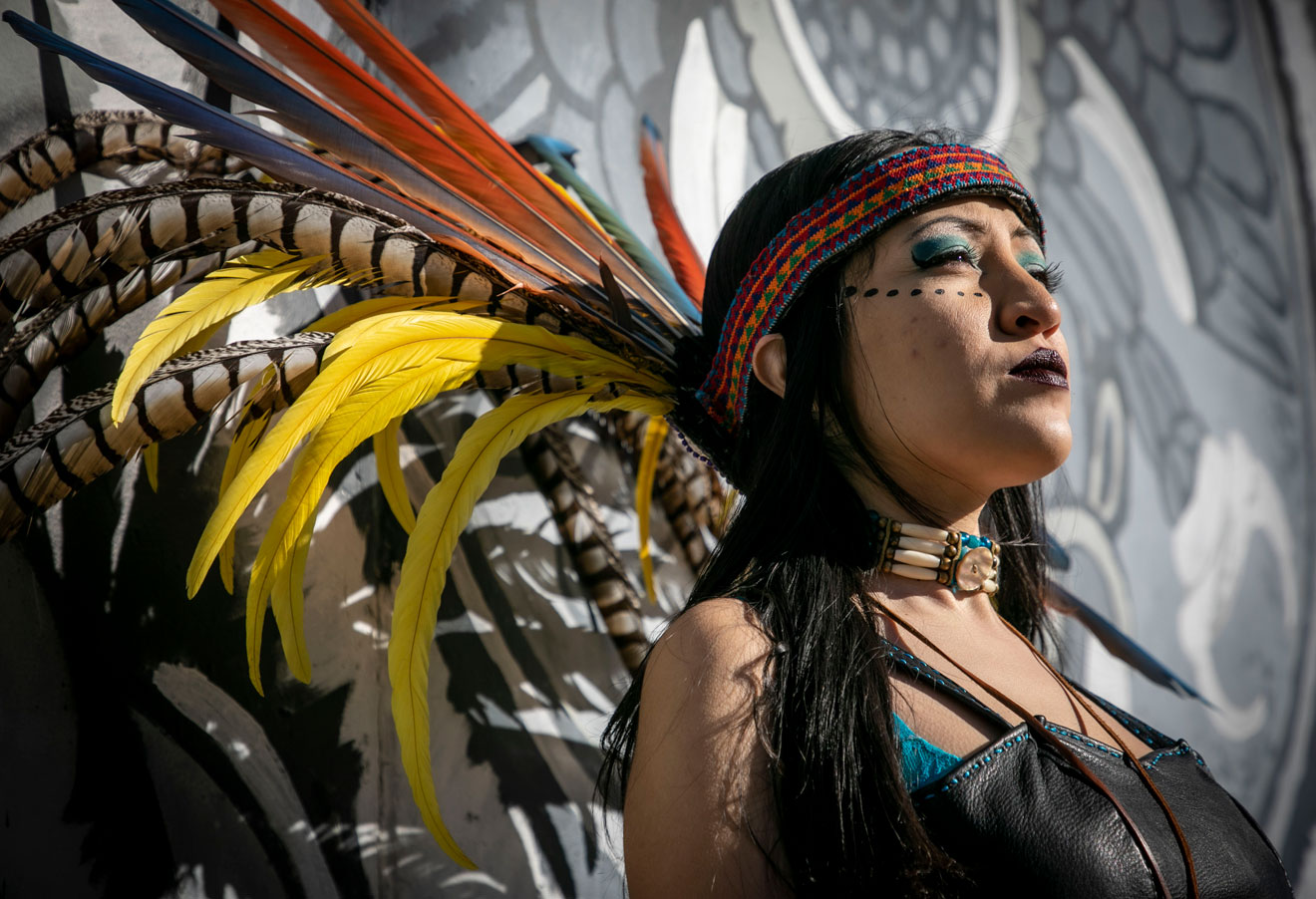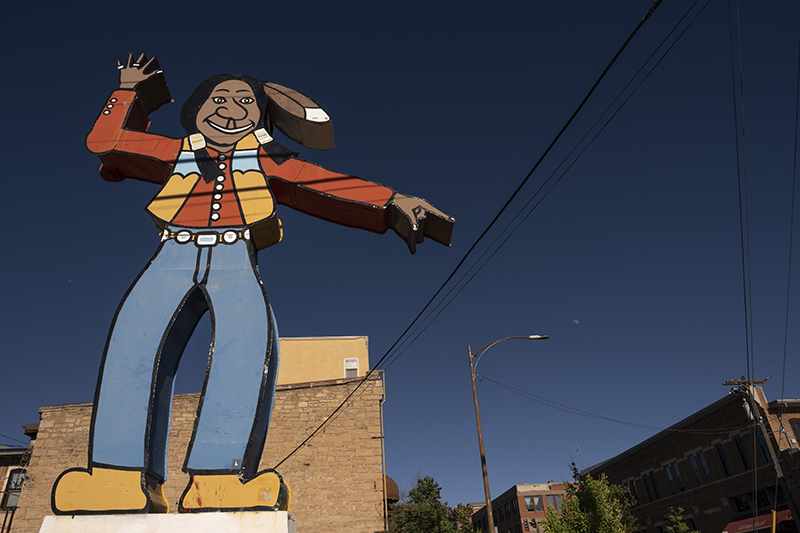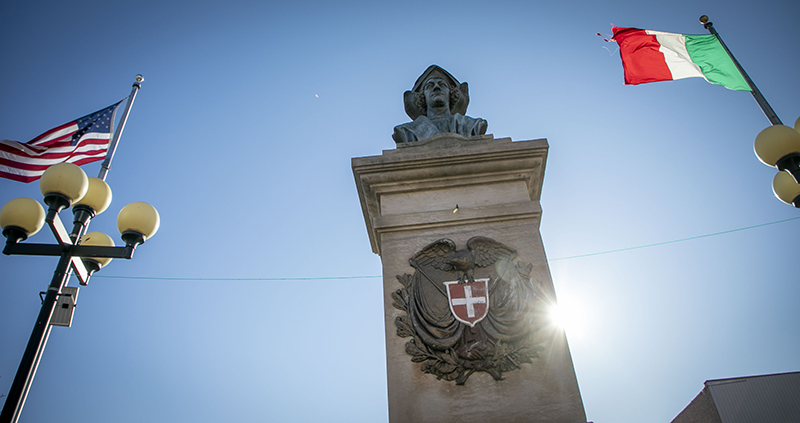
Tziavii Stevens, photographed in Pueblo on Feb. 26, 2021. Photo by Joe Mahoney / Special to The Colorado Trust
Tziavii Stevens, photographed in Pueblo on Feb. 26, 2021. Photo by Joe Mahoney / Special to The Colorado Trust
Tziavii Stevens was born in Denver, and grew up mostly on a reservation in Nevada. She was the only girl on the reservation with a Paiute name. Tziavii means “the wild rose.”
Stevens didn’t grow up particularly politically engaged, but that changed when she went to her first protest in Pueblo, Colo. at the age of 16. She remembers the precise chant that changed the direction of her life. Rita Martinez, a Chicana activist, had taken up the local fight against the veneration of Christopher Columbus at a statue in Pueblo dedicated to him.
“Columbus is a rapist, a slaveholder and a murderer,” Martinez chanted. Stevens was captivated. She started learning about Columbus, and doing the same chants as Martinez.
In the years that followed, Stevens took part in marches and rallies, and in testimonials at the Capitol in Denver against the state’s Columbus Day celebrations.
“I guess the biggest route I would take is the empathy one,” said Stevens. “I’d try to make them understand Indigenous trauma. I’d mention the science. But it’s hard to convince people of the pain that you suffer.”
Twelve more years passed before Stevens and others saw progress. On March 20, 2020, Gov. Polis signed into law a bill that abolished the statewide observance of Columbus Day, replacing it with a holiday in honor of Mother Frances Cabrini.
There was little public fanfare, though. Colorado, like much of the world, was shutting down.
More than 500 years after Columbus’ arrival in the Americas opened the door to diseases that abetted European colonizers’ genocide of Indigenous people, a new pandemic had arrived.
Like its viral predecessors, the novel coronavirus has torn through Indigenous communities with particular vehemence. On reservations including Navajo Nation, among urban Indigenous people, and in Chicano communities, COVID-19 has taken an outsized toll on people with ancestral roots here.
The terrible echo hasn’t gone unnoticed among Native and Chicano activists. For many of them, this year has brought new urgency to old protests. At the same time, the strength of the national protest movement for racial justice, especially after the police killing of George Floyd in May 2020, brought increased visibility—and corporate and legal pressure—to their cause.
Advocates celebrated rare victories in 2020. In the National Football League, the Washington Football Team dropped the Redskins name. Land O’Lakes took a stereotyped image of a Native woman off their butter (but inexplicably left it on other products).
In September, an important Supreme Court decision upheld an old treaty promising about half of Oklahoma’s land to the Muskegee (Creek) Nation. And in October, two new laws were passed to help reverse a record of impunity in violence against Indigenous women.
Christina Leza, PhD is chair of the anthropology department at Colorado College, and a scholar of Indigenous grassroots activism. She said this moment is reminiscent of civil rights victories in the 1960s, when several tribes regained lost land, status and self-determination.
“The George Floyd protest was significant for a lot of white Americans, in terms of getting a clearer sense of how people of color feel about the ways they’ve been marginalized, often in extremely violent ways,” said Leza, who is of Yaqui and Chicana descent.
Among white Americans who hadn’t given much thought to racialized events, she said, “that has increased their ability to be aware of other kinds of protests. The protest has always been there, but Indigenous activism hasn’t had a lot of visibility.”
In the southeastern Colorado town of Lamar, where the high school mascot is the “Savage,” it’s primarily white alumni who are taking up the fight to remove it. They cite data showing how offensive stereotypes and racial slurs harm the mental health of Indigenous young people.
“When I was in high school, it was not much of a conversation. It wouldn’t come up at the same level of scrutiny. I just didn’t get it,” said Stephanie Davis, who graduated from Lamar High School in 2006. “There’s a picture of me somewhere with braids in my hair and paint on my face, and I almost wish I could find it and say, ‘Look, you can grow up and move on from thinking this is OK.’”
She and others put together an online campaign to change the mascot, and met several times with the school board to make their case. The school board is so far unmoved, she said. Neither the superintendent nor the school board president responded to a request for comment.
In many other instances, more white allies are simply joining with or ceding space to Indigenous people who have been in the fight for a long time.
In Colorado Springs, Monycka Snowbird was well-poised to make use of that momentum. Snowbird, who is Ojibwe, is program director of the Haseya Advocate Program, which supports Native survivors of domestic and sexual violence. She is also an organizer with the Colorado Springs Indigenous community.
In January 2020, Indigenous women took the lead in the Colorado Springs Womxn’s March, drawing attention to missing and murdered Indigenous women. Snowbird’s organization worked with the Colorado Springs Police Department to organize a training on addressing domestic violence against Indigenous women. They successfully pushed for the city to make Oct. 12 Indigenous Peoples’ Day.
“Our community has been kicking some butt lately,” said Snowbird.
At the same time, she said, “I get really tired of having to fight against things. I want to be able to fight for things. I’d like to be saying ‘yes.’ The fact that we’re organizing our community is a great thing. But I’m having to bring my grandson to rallies for things I was protesting as a young teenager.”
Mascots are a great example of what she’s tired of fighting against. “I’m so over it,” she said. “But if people continue to see us as mascots, continue to perpetuate stereotypes, continue to see us in inaccurate historical depictions, we can’t move forward.”
Snowbird and others thought they had won a victory when the board of the Cheyenne Mountain School District put forward a draft resolution in September to retire their Indians team name and other Native-appropriated language like “pow wow” and “smoke signals.” But the district later tabled the issue after facing strenuous local opposition. Superintendent Walt Cooper said the board was collecting opinions and feedback from all sides, and planned to take up the issue again in March.
School districts including Lamar and Cheyenne Mountain may find that their hands are forced, if a recently introduced bill passes into state law. The legislation would ban the use of Native mascots and team names in Colorado public schools. Similar laws have passed in other states.
“This year has really been an awakening for people that things we accept should not be accepted,” said Rep. Adrienne Benavidez, a Democrat from Commerce City who is co-sponsoring the bill. She noted that previous legislation to prohibit Native mascots had failed. “The timing seems right to try to bring the bill again.”
With the increased national visibility has come a fierce local backlash in many places—some of it openly menacing.
Durango, which is close to the Ute Mountain Ute Reservation, the Southern Ute Reservation and, across the state border, Navajo Nation, has always had a large population of Indigenous residents.
The college there, Fort Lewis College, was established as an off-reservation boarding school for Indigenous children at a time when official U.S. policy was to forcefully separate children from their families and strip them of their Native cultures and languages.
Today, Fort Lewis offers free tuition to Indigenous students from anywhere in the country, and 41% of its students are Native American or Alaska Native.
Indigenous community members, including students, have long protested a grinning figure with exaggerated features, called the Chief, that is posted outside the Toh-Atin Gallery, off Durango’s Main Avenue. This year, people offended by the sign redoubled their efforts to take it down.

The “Chief” statue erected outside the Toh-Atin Gallery in Durango. Photo by Jeremy Wade Shockley
“There was lots of wanting to piggyback on the national movement because we were actually seeing changes,” said Tirzah Camacho, who graduated from Fort Lewis College in 2004, and has lived in Durango ever since. (Camacho, who is Indigenous, is also a community organizer for The Colorado Trust.) “We thought, this is a no-brainer.”
Residents spoke with the owner of the gallery, petitioned city leaders, held protests and otherwise tried to convince their neighbors that the sign was hurtful.
“It is a caricature,” said Camacho. “It is absolutely insulting to many tribal people and non-tribal people.”
So far, the gallery owner, Jackson Clark, has refused to entertain offers to replace the sign with something contemporary. Clark said he and his family have done a lot for local Indigenous communities—including paying for the funerals of Navajo people who died of COVID-19. He said none of his friends, Native or not, think the sign is racist. Clark blamed the actions against his gallery on anarchists and outsiders.
“These people are not friendly people,” Clark said of the protesters. “Anybody that threatens to destroy your property or tear your property down is not your friend.”
Camacho said they were shocked at the pushback from Clark and others. From Camacho’s perspective, there was an opportunity for the city to attract some positive national attention by taking down the offensive sign and putting something beautiful in its place.
On Oct. 12, a march to celebrate Indigenous People’s Day brought people, including children and elders, down Durango’s Main Avenue. As people were gathering, a group of Trump supporters showed up—some of them armed—and began screaming “USA” at the Indigenous marchers and their allies, and swatting their signs.
“The police department were nowhere to be found,” said Camacho. Instead, the marchers found the police gathered in front of the gallery—“just protecting this white-owned business, not protecting us from the mob on the street down the block.”
Brice Current, deputy chief of the Durango Police Department, denied that the department was primarily concerned with protecting the gallery, but said that several of the Indigenous protesters had told officers to stay away, and so they were respecting their wishes.
In Pueblo, the protests at the Columbus statue started up again after George Floyd’s death. For 22 weeks in the summer, community members gathered at the statue. It became a place to lay out all the grief and fear that the pandemic had surfaced. And not just the pandemic, but all the accumulated betrayals, the brutal indifference and the broken promises that had been killing people for generations.

The statue of Christopher Columbus in downtown Pueblo. Photo by Joe Mahoney / Special to The Colorado Trust
“This is about systemic violence, and systems that have so much control over our lives,” said Theresa Trujillo, one of the organizers in Pueblo. Trujillo, a former Colorado Trust community partner, is now director of community organizing at the Center for Health Progress, a Colorado Trust grantee. “If those systems and those leaders allow such veneration of somebody like Columbus, then there is no hope for ensuring that our needs are met and our rights are protected.”
Stevens and other young advocates took a lead role, and were joined by some older members of El Movimiento Sigue, an organization of the Chicano movement in Pueblo.
“The old guys got involved because we wanted to protect our kids,” said Juan Espinosa, a Pueblo-based journalist who has been chronicling the Chicano movement since the late 1960s.
He’s been writing about police killings of Mexican Americans for decades—long enough to worry. “Not to fault the kids,” Espinosa clarified. “I was more afraid of how the police were going to react to this thing. I know a lot of the police. I know their names and some of their history.”
Pueblo had the highest per-capita rate of police shootings in the state in 2019, a Denver Post investigation found last year.
On one particularly scary day in Pueblo, members of the Proud Boys, a hate group, seemed to easily cross a police line meant to separate them from the protesters, said Trujillo. Martinez helped strategize about keeping the gatherings safe, in part by holding cultural celebrations at their core.
“I danced every Sunday,” said Stevens, who is part of a Native dance group. “The people who were going, they were crying. There was a beautiful unity.”
Pueblo Police Sergeant Franklyn Ortega said the department was proud of how it had handled the protests. Nobody was injured, and no property was damaged, he said: “The final results, to me, were pretty good.”
Charges of anti-Mexican racism within the department are especially painful to him, said Ortega, as a Latino and a dual citizen of Mexico and the U.S. He pointed out that the Pueblo police chief and officers had joined protests for racial justice early in the summer.
“I know what they’re talking about with historical injustice, and I’ve even seen it in the police department,” said Ortega, who remembers previous higher-ups—“my deputy chief, even chief”— throwing around racial slurs like “wetback” and “spic” when he was a younger officer. “But if you’re looking for an example, this isn’t a good one.”
The Sunday gatherings at the Columbus statue became a venue for distributing food, masks and hand sanitizer.
“When everything in life went on hold, that was a way to connect,” said Trujillo. For many in the community, the pandemic had robbed them of the only capital they have, she said. “Social capital is the thing they depend on to survive.”
But the effort to take down the statue went nowhere. Meetings with the mayor and the city council failed to persuade them of anything. Efforts to make use of a mediator “didn’t work out at all,” said Stevens. The Pueblo mayor’s office didn’t respond to a request for comment.
For Stevens, things took a frightening turn when she began to notice somebody following her in a car. Police initially told her that they were looking into someone in their own department as a possible suspect, and then said they had cleared him of any suspicion.
Captain Daniel Anderson, who investigated the case, said the Pueblo Police Department was gathering intelligence on what he said were Antifa activists armed with assault weapons, but that Stevens herself was never under investigation. “We were able to prove that it was not our detective that was following her.”
The protests wound down in the fall, as a surge in coronavirus cases made even outdoor, masked gatherings feel unsafe.
It wasn’t the only thing that felt threatening. Stevens began to worry about her safety, and her young son’s safety. If someone was trying to intimidate her into staying home, it was working.
“They got what they wanted, which is to coop me in my house,” said Stevens. “I don’t even take my son to the playground anymore.”
And then, in December, Rita Martinez died of COVID-19.
Her death devastated the community.
Stevens said she was raised to respect her elders, and with Martinez, it wasn’t hard. “She was a leader. I’m just so lucky to have met her.”
Espinosa said she was the kind of person who could make you do things you couldn’t do.
He used to print up an annual publication for her on Cinco de Mayo, he said. “I always swore I’d never do it again. Every spring, I’d get a phone call and end up doing it again. Even though I was older than her, she was still kind of a mom. She’d grab you by the ear.”
She’s still doing it, said Trujillo. “Rita’s passing has really motivated people to say, ‘I’ve got to get this done.’”
In the middle of the night before her burial on Dec. 18, a shroud appeared on the Columbus statue in Pueblo: “TAKE IT DOWN,” it read. And beneath that, another banner: “QUE VIVA RITA.”
The police removed both banners in the morning.
In the afternoon, with dancing, drumming and singing, a funeral procession took Martinez’s coffin into the street for a final march.